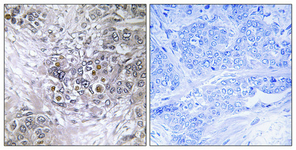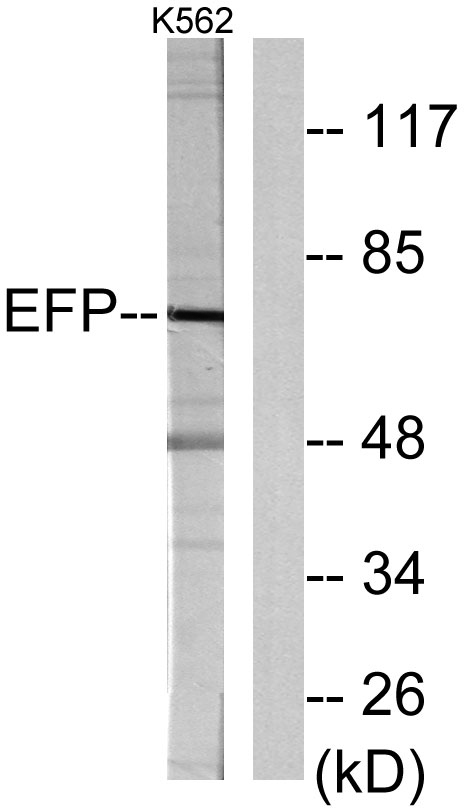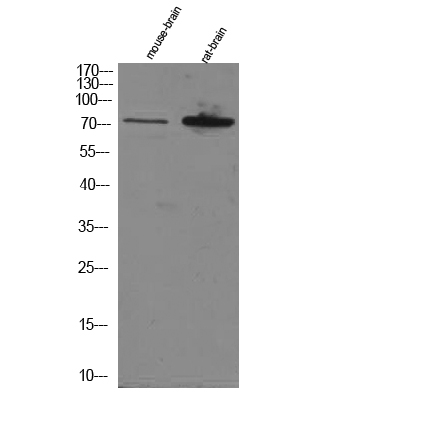EFP Polyclonal Antibody
- Catalog No.:YT1478
- Applications:WB;IHC;IF;ELISA
- Reactivity:Human;Mouse
- Target:
- EFP
- Fields:
- >>NF-kappa B signaling pathway;>>RIG-I-like receptor signaling pathway;>>Influenza A
- Gene Name:
- TRIM25
- Protein Name:
- E3 ubiquitin/ISG15 ligase TRIM25
- Human Gene Id:
- 7706
- Human Swiss Prot No:
- Q14258
- Mouse Swiss Prot No:
- Q61510
- Immunogen:
- The antiserum was produced against synthesized peptide derived from human ZNF147. AA range:201-250
- Specificity:
- EFP Polyclonal Antibody detects endogenous levels of EFP protein.
- Formulation:
- Liquid in PBS containing 50% glycerol, 0.5% BSA and 0.02% sodium azide.
- Source:
- Polyclonal, Rabbit,IgG
- Dilution:
- WB 1:500 - 1:2000. IHC 1:100 - 1:300. ELISA: 1:10000.. IF 1:50-200
- Purification:
- The antibody was affinity-purified from rabbit antiserum by affinity-chromatography using epitope-specific immunogen.
- Concentration:
- 1 mg/ml
- Storage Stability:
- -15°C to -25°C/1 year(Do not lower than -25°C)
- Other Name:
- TRIM25;EFP;RNF147;ZNF147;E3 ubiquitin/ISG15 ligase TRIM25;Estrogen-responsive finger protein;RING finger protein 147;Tripartite motif-containing protein 25;Ubiquitin/ISG15-conjugating enzyme TRIM25;Zinc finger protein 147
- Observed Band(KD):
- 71kD
- Background:
- The protein encoded by this gene is a member of the tripartite motif (TRIM) family. The TRIM motif includes three zinc-binding domains, a RING, a B-box type 1 and a B-box type 2, and a coiled-coil region. The protein localizes to the cytoplasm. The presence of potential DNA-binding and dimerization-transactivation domains suggests that this protein may act as a transcription factor, similar to several other members of the TRIM family. Expression of the gene is upregulated in response to estrogen, and it is thought to mediate estrogen actions in breast cancer as a primary response gene. [provided by RefSeq, Jul 2008],
- Function:
- function:Mediates estrogen action in various target organs.,similarity:Contains 1 B30.2/SPRY domain.,similarity:Contains 1 RING-type zinc finger.,tissue specificity:Ubiquitous.,
- Subcellular Location:
- Cytoplasm . Cytoplasm, Stress granule . Nucleus .
- Expression:
- Expressed in breast tumors (at protein level). Ubiquitous.
- June 19-2018
- WESTERN IMMUNOBLOTTING PROTOCOL
- June 19-2018
- IMMUNOHISTOCHEMISTRY-PARAFFIN PROTOCOL
- June 19-2018
- IMMUNOFLUORESCENCE PROTOCOL
- September 08-2020
- FLOW-CYTOMEYRT-PROTOCOL
- May 20-2022
- Cell-Based ELISA│解您多样本WB检测之困扰
- July 13-2018
- CELL-BASED-ELISA-PROTOCOL-FOR-ACETYL-PROTEIN
- July 13-2018
- CELL-BASED-ELISA-PROTOCOL-FOR-PHOSPHO-PROTEIN
- July 13-2018
- Antibody-FAQs
- Products Images

- Immunohistochemical analysis of paraffin-embedded Human breast cancer. Antibody was diluted at 1:100(4° overnight). High-pressure and temperature Tris-EDTA,pH8.0 was used for antigen retrieval. Negetive contrl (right) obtaned from antibody was pre-absorbed by immunogen peptide.

- Western blot analysis of lysates from K562 cells, using ZNF147 Antibody. The lane on the right is blocked with the synthesized peptide.

- Western Blot analysis of various cell lysis. Primary Antibody was diluted at 1:1000. Secondary antibody(catalog#:RS23920 was diluted at 1:10000



